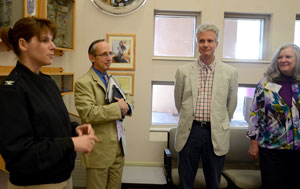Oct 14, 2015
The Realities of Child Poverty: Insights from a National Advisory Committee Meeting
by Brandon Baumbach & Kate Menzies

When the National Advisory Committee on Rural Health and Human Services (NACRHHS) was looking for a location to learn about the realities of child poverty, it had to look no further than the home of committee member Barb Fabre. Mahnomen, Minnesota is at the heart of the White Earth Indian Reservation.
The White Earth Economic Development Office estimates the poverty rate on the reservation to be 24.6%, compared to 11.0% for Minnesota as a whole. The poverty rate for children under 18 is 35.4%.
At the September meeting of NACRHHS, committee members heard from healthcare and human services professionals from across the region about the needs of rural children and families living in poverty. Due to the meeting location, many of the topics discussed were presented through a tribal lens. Insights gained from the meeting will be included in an upcoming NACRHHS Policy Brief to HHS Secretary Sylvia Mathews Burwell.
Jim Koppel, Assistant Commissioner for Children and Family Services within the Minnesota Department of Human Services, discussed how policies shape what children are able to access and achieve. To improve child health outcomes, housing, food, healthcare, and human services all need to be addressed. Koppel asserted that ending poverty isn't necessarily an attainable short-term goal. However, providing stability for children so that they can function at their best is a first step.
“People can be self-sustainable in poverty,” said Koppel. “Predictability and stability make well-being a possibility.”
Looking at population outcomes, not just program outcomes, is necessary to properly address child poverty.
Risk Factors
The Executive Director of Mahube-Otwa Community Action Partnership, Inc., Leah Pigatti, shed light on the many risk factors that children face that could hinder their overall well-being. Lack of education, transportation, nutrition, and shelter makes a child's life unstable which can contribute to poor physical, mental, and oral health. On tribal reservations, however, other issues also play a factor, such as historical trauma.
“It has had a lasting cause and effect on generational poverty with individuals,” said Fabre in an interview following the meeting.
Cultural Competency
Samantha Beauchman, of Sanford Health Mahnomen Clinic, discussed how important cultural competency was to the delivery of care in the area.
Building relationships with families and service providers is important, especially in rural communities. The isolation factor in rural communities leads to distrust for outside agencies or outside community members.
The lack of providers in the region, coupled with the distance involved with receiving care, often leaves people seeking services only when a crisis arises. Beauchman touched on the importance of holistic care, and how collaboration can increase the access to care. Several representatives of the committee voiced the advantages of mobile health clinics and telehealth programs. Unfortunately, in the White Earth area, the lack of broadband availability is a significant barrier for telehealth.
Fabre added, “Building relationships with families and service providers is important, especially in rural communities. The isolation factor in rural communities leads to distrust for outside agencies or outside community members.”
Thomas Schreiner, of Indian Health Service, said a large Indian reservation like White Earth requires multiple satellite clinics. However, these clinics have limited services and hours due to staff shortages. Indian Health Service is currently working to utilize local home health nurses and Community Health Workers (CHWs) to combat this barrier and better serve residents.
Fabre notes that progress has been made. Social service programs and tribal government/programs have been working more closely together to find new innovative approaches to delivering care in the area.
“More communication between programs — tribal and non-tribal — has helped increase awareness, services, and outreach to families through home-visiting, an innovative case management delivery system, data collection, and thinking outside of the box,” said Fabre.
